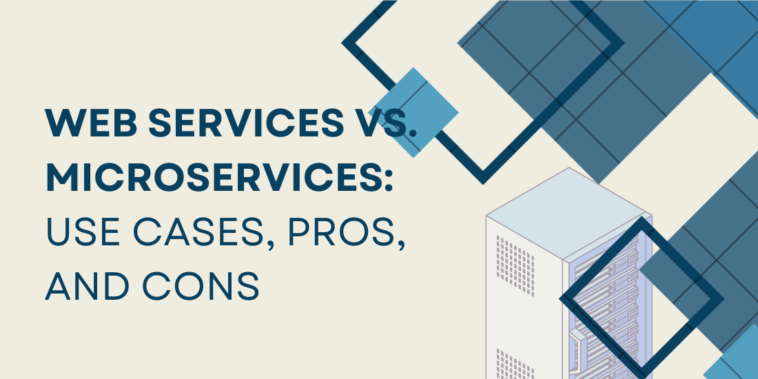Introduction
In the ever-evolving landscape of software development, choosing the right architectural approach is crucial for building robust, scalable, and maintainable applications. Especially when we need ways of enabling communication and data exchange between different applications over the internet or an intranet, choosing the right architecture is crucial to success of the project.
Two popular architectural styles that often vie for developers’ attention are Web Services and Microservices. In this article, we will explore the basics of both the prominent approaches, key differences, use cases, and the pros and cons of each approach, helping you make informed decisions for your projects.
Web Services:
In the interconnected world of technology, applications often need to communicate and share data with each other, regardless of their underlying technologies and platforms. Web Services fulfil this need by providing a standardized way for applications to interact over the internet or an intranet. Here are some key reasons why Web Services are required:

a. Interoperability: Web Services enable different systems to communicate seamlessly, breaking down the barriers of platform and programming language differences. This interoperability fosters collaboration and data exchange between diverse applications.
b. Integration: In complex enterprise environments, various applications and systems need to work together cohesively. Web Services facilitate integration, allowing businesses to create unified solutions that bring together different technologies.
c. Distributed Architecture: Web Services enable the creation of distributed applications, where components can run on separate servers or even different geographical locations. This distributed architecture enhances scalability, fault tolerance, and resource utilization.
d. Industry Standards: Web Services adhere to well-defined standards like SOAP and REST, providing a common set of rules and guidelines for data exchange. These standards ensure consistency, security, and reliability in communication.
Web Services is a general term that encompasses various technologies for communication between applications over a network. The communication is typically performed using XML (eXtensible Markup Language) or JSON (JavaScript Object Notation) as the data format, and the interaction is facilitated through standard web protocols like HTTP (Hypertext Transfer Protocol) or SMTP (Simple Mail Transfer Protocol).
There are mainly two types of Web Services:
SOAP (Simple Object Access Protocol): SOAP is a protocol that uses XML for message exchange. It follows strict rules and specifications, making it more heavyweight compared to other alternatives. SOAP-based Web Services often require more complex XML processing and are typically used in enterprise environments where strong security and reliability are crucial.
REST (Representational State Transfer): REST is an architectural style that operates over standard HTTP methods like GET, POST, PUT, DELETE, etc. It uses simple data formats like JSON or XML for data exchange. RESTful Web Services are lightweight and flexible, making them popular for modern web and mobile applications.
Use Cases:
1. Integration: Web Services are often employed for integrating disparate systems and applications, enabling seamless communication between them. It also helps in enabling communication between different services in a service-oriented architecture (SOA).
2. Platform Independence: Web Services allow different platforms and programming languages to interact, promoting interoperability.
3. B2B Communication: Businesses can use Web Services for secure and standardized communication with partners, clients, or suppliers.
Pros:
1. Platform Independence: Web Services allow for cross-platform communication, facilitating seamless integration across diverse systems.
2. Language Agnostic: Different programming languages can easily interact with Web Services, offering flexibility for development teams.
3. Robustness: The strict rules and specifications of SOAP-based Web Services ensure reliability and security.
Cons:
1. Complexity: SOAP-based Web Services can be more complex and require extensive XML processing, resulting in a higher overhead.
2. Performance: The XML-based data format used in SOAP can make data payloads larger, potentially impacting performance in high-traffic scenarios.
3. Learning Curve: Implementing SOAP-based Web Services may require a steeper learning curve for developers due to its strict nature.
Microservices:
In recent years, software development has evolved to meet the demands of modern, agile businesses. Microservices architecture has emerged as a response to the limitations of traditional monolithic applications. Microservices fulfill the following needs:

a. Modularity: Microservices break down large applications into small, self-contained services. Each service is focused on specific business capabilities, making the application easier to develop, maintain, and scale.
b. Agility and Continuous Delivery: By adopting Microservices, development teams can work independently on different services, allowing faster development cycles and continuous delivery. This agility enables businesses to respond quickly to changing market demands.
c. Scalability: Microservices architecture allows individual services to scale independently based on demand. This fine-grained scalability optimizes resource utilization and ensures high performance during peak periods.
d. Fault Isolation: In traditional monolithic applications, a single bug or failure can bring down the entire system. Microservices offer fault isolation, meaning that if one service fails, it doesn’t impact the overall functionality of the entire application.
e. Technology Diversity: With Microservices, different services within an application can be built using various technologies and programming languages. This flexibility allows teams to choose the best-suited tools for each specific task.
Microservices is an architectural style where a large application is divided into smaller, independent services that communicate through lightweight APIs. Each microservice is designed to handle a specific business capability, fostering agility and scalability.
Use Cases:
1. Scalability: Microservices are well-suited for applications requiring dynamic scalability, as each service can be scaled independently based on demand.
2. Rapid Development: Microservices enable multiple development teams to work concurrently, speeding up the development process.
3. Continuous Deployment: Microservices promote a DevOps culture, allowing faster and more frequent releases of individual services.
Pros:
1. Scalability: Each microservice can be scaled independently, efficiently utilizing resources and optimizing performance.
2. Agility: Microservices facilitate faster development cycles and encourage continuous delivery, enabling quicker responses to market demands.
3. Fault Isolation: Failures in one microservice do not disrupt the entire application, improving overall system resilience.
Cons:
1. Complexity of Orchestration: Managing and coordinating multiple microservices can introduce complexities in terms of service discovery, communication, and monitoring.
2. Distributed System Challenges: Working with a distributed architecture introduces challenges in maintaining consistency, resilience, and fault tolerance.
3. Increased Network Overhead: Communication between microservices can result in additional network overhead, which might impact performance.
4. Maintenance: While dealing with microservices you may require to put dedicated resource to manage and maintain the docker. Additionally, die to sufficient hosting infrastructure with security and maintenance support it needs lots of skilled staff and development teams.
Conclusion:
In conclusion, choosing between Web Services and Microservices largely depends on the specific requirements of your project. Microservices and web services each offer unique benefits and drawbacks.
Web services are widely used for communication and data exchange between diverse applications and platforms, making them effective in larger corporate application systems due to their seamless integration capabilities. Web Services, with its platform independence and robustness, serves as an excellent choice for integrating diverse systems and enabling B2B communication.
On the other hand, Microservices, with its agility, scalability, and fault isolation, is an ideal choice for large-scale applications that require continuous development, deployment, and scalability. Microservices are best suited for enterprises with a culture of distributing work among small teams, providing reliable and scalable applications, making them ideal for startups.
Ultimately, the decision should be based on factors such as the complexity of your project, team expertise, performance requirements, and the potential for future growth. By understanding the use cases, pros, and cons of each architectural style, you can make a well-informed choice that aligns perfectly with your development goals and objectives.





Comments
0 comments